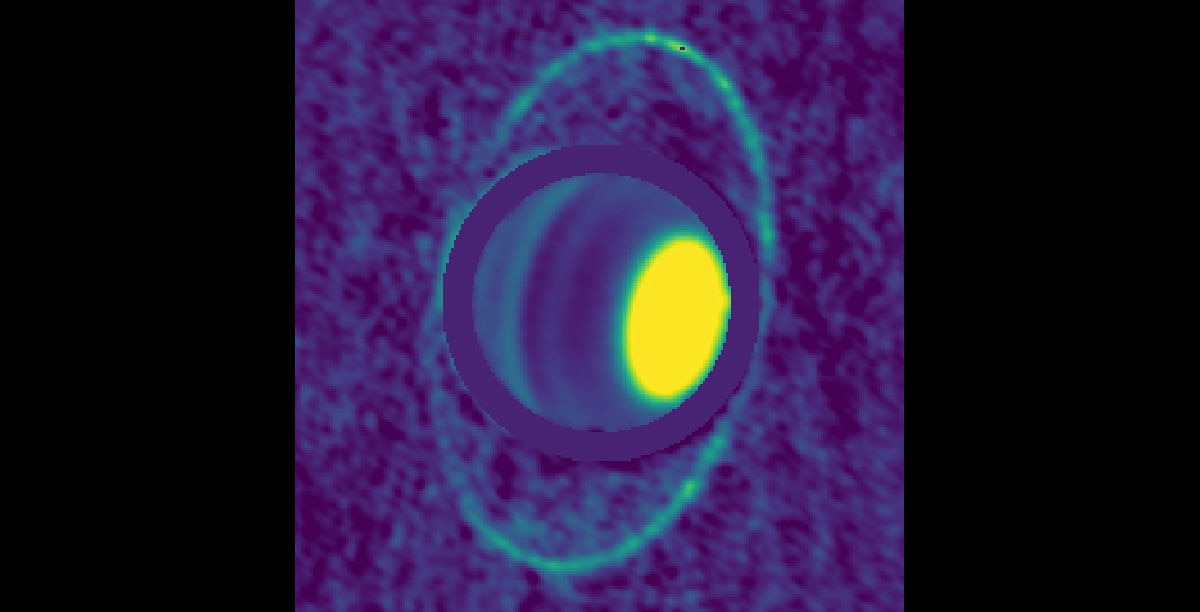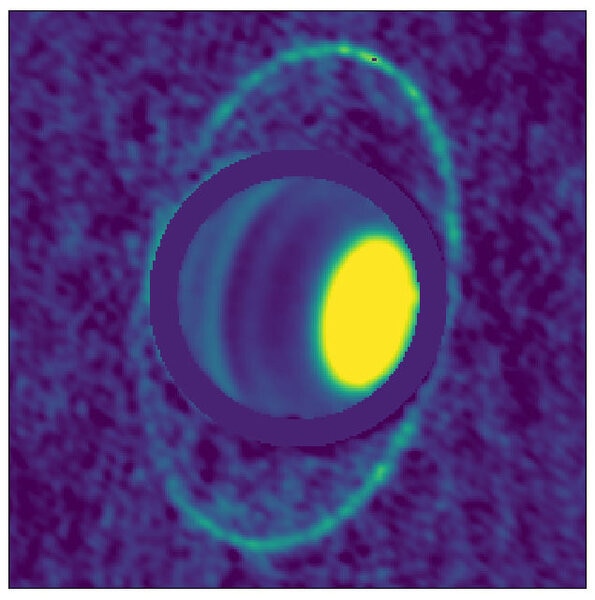Create a free profile to get unlimited access to exclusive videos, sweepstakes, and more!
The warm glow of rings around Uranus

All four of the giant planets in our solar system have rings. Saturn’s are obvious, Jupiter’s are incredibly thin, and while Neptune has rings one of them has bright regions that form more obvious arcs, the cause of which is unknown.
Uranus has rings, too. Observations from the ground and from spacecraft have determined there are at least ten narrow rings made of icy particles, and also three broader, dustier rings. Uranus’s rings are dark in visible light, meaning they don’t reflect much sunlight, making them hard to see from Earth.
But a fun thing about dark things that absorb sunlight is that they get warmer. A fundamental rule of physics is that anything above a temperature of absolute zero emits light, and the wavelength (color) where it emits most of its energy changes with temperature. So while the rings of Uranus don’t reflect much sunlight, they are warm enough to emit light. It would be way outside what our eyes can see, in the far infrared (sometimes called “thermal infrared”) and even longer wavelengths, like in the millimeter range.
Recently, astronomers observed Uranus in those wavelengths using the Very Large Telescope (sensitive to thermal IR) and ALMA, the Atacama Large Millimeter/submillimeter Array, both in Chile. The purpose of the observations was to look at the atmosphere of the giant planet, but to their surprise one of the rings was bright enough to easily spot in the images!
The bright ring you can see in those images is the ε (epsilon) ring, the brightest of all of them. Although not visible by eye, several other rings are also detected in the images (they show up if you collect all the light from elliptical annuli (rings) around Uranus at the correct distances and add all the light up). This is the first time the rings have ever been seen in emitted thermal light; previous observations always show them reflecting sunlight.
The cool thing about this — literally — is that this means the temperature of the ring particles can be measured (since, again, the way objects emit light depends on temperature). The astronomers found the ring particles have a temperature of 77 Kelvins — that’s about -200° C, around the temperature nitrogen condenses from a gas to a liquid. So yeah, we’re talking cold here… but still, that’s warmer than you’d expect for ice at Uranus’s distance from the Sun, even if the particles are dark.
The reason for this depends on a couple of things, including how well the particles shed heat (what’s called thermal inertia), and how fast the individual particles rotate. The first part may make intuitive sense to you; some everyday objects retain heat better than others. A glass cake pan stays hot longer than a metal one will after you pull it out of the oven, for example. That means glass has a higher thermal inertia than metal, so it takes longer to cool off (in reality it’s more complicated than this, because stuff in your kitchen cools through conduction, heating the air that’s in contact with it, whereas stuff in space has to radiate away that heat as light, a much less efficient process).
The other part, about spin, is a little odder. What’s going on there is that a ring particle is sitting in sunlight, so one half of it gets a bit warmer than the half facing away from the Sun. If the particle spins quickly, any given part of its surface doesn’t have much time to radiate away that heat before getting warmed again as it spins back into sunlight. The whole particle is roughly at the same temperature. If it spins slowly, though, the side facing the Sun is much warmer than the dark side, which has time to radiate away heat and therefore get cooler.
The observations of the rings indicate that the sunlit and dark sides of the ring particles are at different temperatures, so either they spin slowly or have a low thermal inertia. I know this may seem esoteric, but it’s evidence like this that helps scientists build up a picture of what’s happening in those rings; we can figure out what the ring particles are made of and how they react to their environment.
Speaking of which, the new results also indicate that there’s not much dust between the rings. The new observations are not sensitive to dust like that, yet match other observations that are. If there were dust there, the observations would look different.
This also implies that in the ε ring the particles are rather big, with none smaller than roughly a centimeter or so across (say, the size of a grape or a golf ball). That’s very different from Saturn’s rings, where stuff as small as a micron (a millionth of a meter; a human hair is about 100 microns wide) is common. The particles in the rings of Uranus are far bigger than that, which implies they have a different origin (or, more likely, a different history) than Saturn’s rings. Maybe they don’t grind into each other as much, or maybe small particles are blown out by some mechanism acting in the environment of Uranus.
That’s not clear, so it’s yet another mystery to be solved. There are a lot of really basic tings we still don’t know about the outer planets, and observations like this help. It would be even better to have a big Cassini-like mission to Uranus and/or Neptune, something that could spend a few years there to really take a good look around. There are some ideas being mulled over by NASA, but we’re a ways yet from seeing an actual mission come from them.
I hope that changes sometime soon. Uranus and Neptune are the only planets in the solar system that have never been orbited (if you like to think of Pluto as a planet it hasn’t either, but New Horizons did get tons of hi-res images, where the images of Uranus and Neptune from Voyager 2 aren’t as crisp). There’s still a lot to learn about both of them.




























